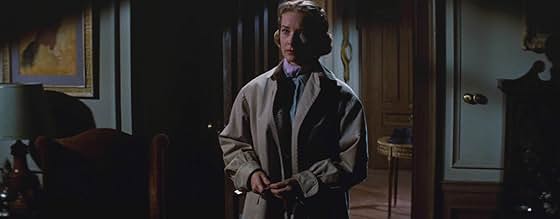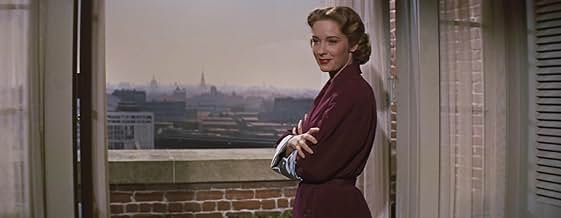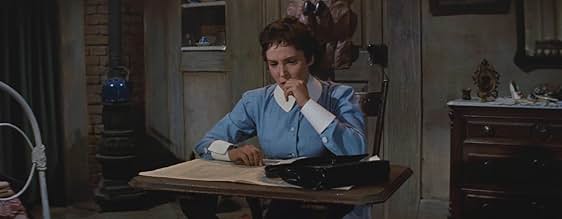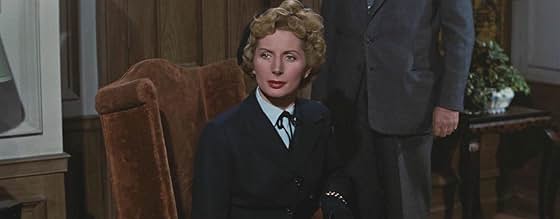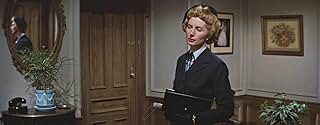NOTE IMDb
6,9/10
3 k
MA NOTE
Ajouter une intrigue dans votre langueA blind American writer living in London stumbles upon a criminal conspiracy involving kidnapping and extortion.A blind American writer living in London stumbles upon a criminal conspiracy involving kidnapping and extortion.A blind American writer living in London stumbles upon a criminal conspiracy involving kidnapping and extortion.
- Réalisation
- Scénario
- Casting principal
Robin Alalouf
- Bellboy
- (non crédité)
Ashley Cowan
- Lift Operator
- (non crédité)
Arthur Gomez
- Mr. Da Mestre
- (non crédité)
A. Cameron Grant
- Pinball Player
- (non crédité)
Fred Griffiths
- Taxi Driver
- (non crédité)
Walter Horsbrugh
- Shop Assistant
- (non crédité)
Janice Kane
- Miss Da Mestre
- (non crédité)
Avis à la une
Hathaway was a brilliant director.He did never,until the very end ("the last safari")produce anything truly mediocre:from "the witching hour" to "True Grit "and "Nevada Smith,his work encompasses such classics as "lives of a Bengal lancer" "Peter Ibbetson" "House on 92 th street" "kiss of death" "niagara" "Legend of the lost",sorry if I cannot mention them all.
Influenced by Hitchcock's "rear window" (Vera Miles was a Hitchcockesque actress although she had yet to work with him in 1956 ),"23 paces to Baker street" ,on the other hand ,had on strong influence on Frederick Knott whose "wait until dark" was transferred to the screen by Terence Young with Audrey Hepburn in 1967: the scene of the "broken lights" was stolen from Philip McDonald.("Now we are equal;not afraid of the dark,are you?") "23 paces to Baker Street" should appeal to people who enjoyed the two movies I mention above;it takes place in a foggy London,with plenty of suspense and a plot which is sometimes a bit complicated and far-fetched but it does not matter:you watch it just like you read Agatha Christie's books.
Influenced by Hitchcock's "rear window" (Vera Miles was a Hitchcockesque actress although she had yet to work with him in 1956 ),"23 paces to Baker street" ,on the other hand ,had on strong influence on Frederick Knott whose "wait until dark" was transferred to the screen by Terence Young with Audrey Hepburn in 1967: the scene of the "broken lights" was stolen from Philip McDonald.("Now we are equal;not afraid of the dark,are you?") "23 paces to Baker Street" should appeal to people who enjoyed the two movies I mention above;it takes place in a foggy London,with plenty of suspense and a plot which is sometimes a bit complicated and far-fetched but it does not matter:you watch it just like you read Agatha Christie's books.
If you have worn out all your Hitchcock videos and need a good way to fill in a few hours on a rainy afternoon, this is the movie for you. A blind play-write over hears a fiendish conversation and is determined to intervene. Armed with his trusty man-servant and beautiful American female companion, this flick delivers on many levels, right up to the twist at the end.
They don't seem to make movies like this one anymore. Mores the pity. A must see for all suspense fans, plus a lovely glimpse into 50's London.
Scored it as 8/10.
They don't seem to make movies like this one anymore. Mores the pity. A must see for all suspense fans, plus a lovely glimpse into 50's London.
Scored it as 8/10.
Passable suspenser despite a rather muddled script that doesn't acquaint us well with either the suspects or the plot developments. Thus the mystery part minimizes needed involvement. Johnson does an acceptable job feigning a blind man, but perhaps his biggest triumph is removing any sentimentality from Hannon's affliction. Thus the film never, to its credit, descends into the kind of treacle it so easily could have. In fact, Hannon remains understandably irascible throughout.
That tightrope struggle on the crumbling roof is a real nail-biter and the film's dramatic highpoint. But frankly the showdown in Hannon's darkened apartment lacks the skillful development of, say, Wait Until Dark (1967), to become memorable. The live London backdrop, however, adds a lot of interesting color and is well photographed. And though she's winsome as heck, Vera Miles is largely wasted in a part that many lesser actresses could have filled. Anyway, the movie's an acceptable time passer with a few good moments, but I'll bet it's not on Scotland Yard's Must-See list.
That tightrope struggle on the crumbling roof is a real nail-biter and the film's dramatic highpoint. But frankly the showdown in Hannon's darkened apartment lacks the skillful development of, say, Wait Until Dark (1967), to become memorable. The live London backdrop, however, adds a lot of interesting color and is well photographed. And though she's winsome as heck, Vera Miles is largely wasted in a part that many lesser actresses could have filled. Anyway, the movie's an acceptable time passer with a few good moments, but I'll bet it's not on Scotland Yard's Must-See list.
This I assert is a minor masterpiece of film-making, which has long been underestimated by critics but never by fans. Its images, I suggest, burn themselves into the mind where other cinematic tales soon pale and are forgotten. To mention just a few scenes, the film presents a blind playwright describing the view of the Thames to the fiancé he left behind, a lovely nanny who isn't quite what she seems playing another nanny or perhaps not, a sightless man guiding a lost man through a fog, the same man discovering that a building's front isn't there and a battle in the darkness between a murderer and victim. The script, adapted from a tense Philip MacDonald novel by Nigel Balchin, was made into what I say is an expensive-looking and relentlessly beautiful film by veteran director Henry Hathway. Henry Ephron produced, and every element was realized seemingly by flawless skill, from understated music by Leigh Harline to the cinematography by Milton R. Krasne, to the art direction by Lyle Wheeler and Maurice Ransford, to the outstanding set decorations by Walter M. Scott and Fay Babock and costumes by Travilla. Add famed Ben Nye as makeup artist and the great Helen Turpin as hair stylist and it would be hard for this film to have gone anything but very right. The cast is headed by lovely young Vera Miles as the love interest and Van Johnson coming near something very fine as the blind playwright, Philip Hannon. Maurice Denham plays a befuddled police Inspector, and Cecil Parker tries hard as Hannon's assistant. Patricia Laffan has her best role since Quo Vadis as the mysterious Miss MacDonald, stealing every scene she is in. Other actors showing to advantage include within this strongly-made and taut fictional noir mystery Liam Redmond, Isobel Elsom, lively Estelle Winwood, Martin Benson, Natalie Norwick, and Terence de Marney. On the grounds of pace, intelligence of dialog and sheer memorability alone, this is a Top Hundred film, and the father to many stories starring blind protagonists from TV's "Longstreet" to "Wait Until Dark". There had been films about a blind central character before; but this Technicolor, attractive and exciting film was the project that brought the idea of such films to the minds of producers and viewers alike as none before had done. The mystery I believe is an interesting one, the characters believable from first to last, and the extraordinary work by Patricia Laffan and Vera Miles raise the film far above its competitors' best. It is clearly much better than "in the Heat of the Night", the obsessive "Vertigo" or even "Key Largo". And its makers accomplish its power without striving consciously to achieve it. Were it not for "Rear Window", the film might be considered the best 50's noir of all. I recommend it unreservedly.
On a visit to London, an apparently recently blinded American playwrite over-hears a highly suspicious conversation which may or may not mean a kidnapping... together with his manservant and former secretary he begins to try and put the pieces together.
For 1956 this is a surprisingly twisted piece, involving both highly unconventional villain and target/victim. Delicious shots of mid-50's London (check out Barker's of Kensington), a serviceable performance by Johnson, Miles decorative but wasted (except in one scene), the glorious Parker, and Winwood hamming it up to the hilt, all add up to an enjoyable sub-Hitchcockian romp. Yes it owes a debt to 'Rear Window', but then 'Wait Until Dark' owes a debt to this!
For 1956 this is a surprisingly twisted piece, involving both highly unconventional villain and target/victim. Delicious shots of mid-50's London (check out Barker's of Kensington), a serviceable performance by Johnson, Miles decorative but wasted (except in one scene), the glorious Parker, and Winwood hamming it up to the hilt, all add up to an enjoyable sub-Hitchcockian romp. Yes it owes a debt to 'Rear Window', but then 'Wait Until Dark' owes a debt to this!
Le saviez-vous
- AnecdotesThe department store visited by Alice MacDonald and Bob Matthews was a genuine shop, Barkers of Kensington. The 135-year-old art-deco establishment closed in January 2006.
- GaffesThe depicted Portman Square apartment is directly over the Thames. However, Portman Square is actually about 2 miles from the Thames.
- Citations
Phillip Hannon: [blind man] Well how does it look? Is it beautiful?
Bob Matthews: Yes... yes, very beautiful - view, buildings.
Phillip Hannon: [sarcastically] You make it all so vivid, I can almost see it.
- ConnexionsReferenced in The crimes of the black cat (1972)
Meilleurs choix
Connectez-vous pour évaluer et suivre la liste de favoris afin de recevoir des recommandations personnalisées
- How long is 23 Paces to Baker Street?Alimenté par Alexa
Détails
- Date de sortie
- Pays d’origine
- Sites officiels
- Langue
- Aussi connu sous le nom de
- A 23 pas du mystére
- Lieux de tournage
- Barkers of Kensington, 63 Kensington High Street, London, Greater London, Angleterre, Royaume-Uni(Bob Matthews follows Alice MacDonald into the department store and takes a photograph of her)
- Société de production
- Voir plus de crédits d'entreprise sur IMDbPro
Box-office
- Budget
- 1 375 000 $US (estimé)
- Durée
- 1h 43min(103 min)
- Rapport de forme
- 2.55 : 1
Contribuer à cette page
Suggérer une modification ou ajouter du contenu manquant


